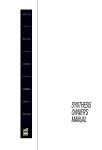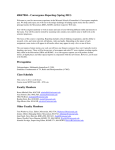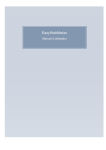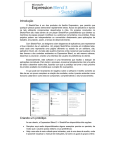Download Wiley Web Design with HTML and CSS Digital Classroom
Transcript
Lesson 1 What you’ll learn in this lesson: • Defining the goals of web design • Defining the user experience AL • Understanding the MA TE RI difference between wireframes, prototypes, and mockups TE D Planning Your Website RI Starting up GH In this lesson, you’ll learn how to improve your website by clearly defining what you want the site to do during the planning process. 1 CO PY This lesson does not use any lesson files, so you do not need to load any files before starting this lesson. See Lesson 1 in action! Use the accompanying video to gain a better understanding of how to use some of the features shown in this lesson.You can find the video tutorial for this lesson at www.digitalclassroombooks.com using the URL provided when you registered your book. The goals of web design To understand how to create well designed websites, it is worth understanding the fundamentals of design. Good design creates experiences that makes people’s lives easier, and is also aesthetically pleasing. Here are some examples: a well-designed store makes it easy for customers to find products they are looking for, or maybe even products they never knew Lesson 1, Planning Your Website 7 1 The goals of web design they wanted. Drivers can see well-designed road signs from a distance and the message of the sign can be immediately understood, even at a high rate of speed while driving. A welldesigned chair is comfortable to sit in and also fits in with the style of the room. A store, a sign, and a chair are all designed with a specific intent. In all these cases, the designer took time to plan the outcome using their skill and experience, as well as resources such as materials and available budget. Different disciplines require different design tools. The web designer is often required to organize information, give it meaning, and assemble it in a way that is visually attractive using available tools. When designing for the web, there are some unique challenges compared to other disciplines arising from the fact that web design is still in its infancy and is evolving rapidly. Even the definition of web design is evolving and difficult to define. Originally, web design meant designing pages for a web browser. While this is still true, you now need to consider the rapidly evolving nature of mobile devices, tablets, smart phones, and consumer electronics that access the web. Some people make the distinction between mobile design and web design, but this distinction is evaporating as mobile devices are evolving. For many web professionals, this rapid evolution of the medium is part of what makes it such an exciting field. Although the design of websites is an evolving field, designers do not need to reinvent the wheel. Web design’s closest relative is print design, and although the two are distinctly different it is worthwhile to compare and contrast them. The difference between print design and web design Print involves seeing; the web involves doing. Books, magazines, posters, newspapers, brochures, and advertisements all contain information, usually text and images, whose intent is to deliver some sort of message or content to a reader. More importantly, designers often try to build a call to action into their work that makes a customer believe there is some action they should be taking as a result of the design. 8 Web Design with HTML and CSS Digital Classroom 1 The goals of web design • A visually exciting movie poster’s call to action might be, “Go see this movie!” • A political campaign displays signs with the call to action, “Vote for me!” • An advertisement in a magazine offering a free sample might have the call to action, “Contact us to learn more!” In this 19th century advertisement the call to action implores the customer to see the product before going home. Compare a print flyer for a shoe sale with its online counterpart. The call to action for the print flyer is, “Show up at the store this Saturday to buy these shoes at a discount.” The information regarding the sale might be enough to compel the customer to get in their car and go shoe shopping on Saturday, but the designer helps to present the information in a way that is well organized and gets noticed. Using color, type, and perhaps an illustration or image, the designer helps to convince the potential customer of the value of this sale. In some sense, you could say that the print designer’s job is done when she sends the file off to the printer. If the customer shows up in the store, it becomes the salesperson’s job to complete the sale. Lesson 1, Planning Your Website 9 1 The goals of web design Now let’s examine the web designer who is largely responsible for leading the prospective customer through the entire process. If an interested customer comes to the shoe store’s website, perhaps there is a button that the user clicks to see the shoes that are on sale. The customer then needs some way to gather more data on the shoes; perhaps there is a table listing the available shoe sizes, colors, and brands. If the customer takes the leap and puts a shoe into the site’s shopping cart, this shopping process needs to be designed as well. In both of these examples, the end result is hopefully the same for the shoe store’s owner: the customer buys the shoes. In both cases information is transferred from the store to the customer; however, in the case of the website, the designer is involved in all stages of the sale process. This is a crucial concept to understand: the web is an active medium and the term to describe this design process is user interaction design. The web demands user interaction The experience of a website is defined by the interaction the user has with it. For example, a user clicks on navigation or scrolls down to read a page. Even the act of reading a book can be defined as user interaction. In the Western world, people read from left to right down a page, they turn pages, and scan page numbers and tables of contents in order to find a certain chapter or topic. Coming back to the web, you don’t just have readers — you have users. Think of the verbs that describe what you do online: you search websites, watch the weather report, transfer money between accounts, book airline flights, and do many other things. The designer needs to think in these terms when designing pages, anticipating the user’s motivation for coming to the site. You not only can read an online newspaper, but search, print, email, tweet, comment and listen. 10 Web Design with HTML and CSS Digital Classroom The goals of web design 1 Defining the user experience When it comes to user interaction, offering too many options can be just as bad as not offering enough. If there are multiple pathways available to the user, it is the designer’s responsibility to make sure the user doesn’t get lost. The entire sum of a user’s interactions with a website can be called the user experience. The focus on the user experience differentiates websites from printed products more than anything else. This job is so important that there are web professionals called information architects. Information architecture is defined as the structure of a website and its pages: how the site and the site navigation are organized. In its strictest form, information architecture is not concerned with issues such as color, type, and graphics. In larger design agencies, it is not uncommon to have an information architect collaborating with the designers, especially at the beginning stages of designing a website. Designers need to think like information architects to be effective. The designs need to provide the best structure allowing users to get the information they want. For online stores, they should provide the most efficient way to allow a user to put an object in a shopping cart and make a purchase. Designers must fully comprehend the web as a medium and understand its rules and possibilities regarding visual design and text. User-centered design It can be difficult to describe how a web designer works because the level of involvement in a project can vary, from developing a project on her own, to being part of a large team in an advertising agency. However, in all cases, the designer’s goal is to create sites that serves the needs of the users. The following section outlines the planning process so that you clearly understand what the client wants before you begin. The stages of the planning process The stages of the planning process can generally be defined as: • Defining goals and strategy • Research • Information architecture • Sketching • Wireframes • Mockups You’ll learn more about each of these stages in this chapter. Lesson 1, Planning Your Website 11 1 The goals of web design Defining goals and strategy When designing a website, an important question to ask is, “Why does this website need to exist?” It seems strange but a client might not be able to tell you exactly why they want a website. The answer, “Because everyone else has one,” is not a good answer. Imagine a carpenter who is hired by a homeowner to build a “structure” in their backyard, with little information provided about the final project. The carpenter needs to know the purpose of the structure. Do they want a shed? A bandstand? A garage? Just as structures have different purposes, so do websites. As a designer you should be able to define, or have the client define, the goal of the website in a simple sentence. For example, in this book, you will be designing a site called SmoothieWorld, which has the following goal: To be the first stop on the web for people looking for Smoothie recipes. Although the designer may not have defined this objective, she can certainly contribute to the conversation. Here are some of the questions that might arise in discussing the functionality and design of such a site: • Will the site be free? If yes, will there be advertising and is that something the designer needs to include in the layout? • Has the client considered how they want to organize the recipes on the site? For example, could a user submit ingredients they have on hand and receive a recipe in return? • What, if any, user interactions might there be on site. For example, can users submit recipes or simply browse existing ones? In larger organizations, these conversations might also involve web developers, who would be responsible for any database functionality, along with the marketing department, the sales department, and other interested stakeholders. Even if these discussions take place before you, the designer, are brought into the project, you will want to have a good understanding of the goals of a website before you start any design work. Research A designer who is practicing user-centered design needs to have some background on what visitors to a site might be expecting. Competitive research is one way to find this information. In the SmoothieWorld example, there may not be many competing smoothie sites; however, there are certainly a number of popular recipe and cooking sites.You should understand how these sites are designed and what makes them so attractive to users. In some cases, research can be objective. Perhaps the SmoothieWorld site has existed for some time and is being redesigned. This is an ideal situation because there should be some data from the history of the site that you can access.You could request the server logs from the client. A server log is a record of information that most servers collect by default and is often accessible from the hosting company or Internet service provider (ISP) for the site. The raw data from 12 Web Design with HTML and CSS Digital Classroom The goals of web design 1 server logs is not particularly useful until it has been organized. This organization of server log data is done with analytic software. Analytic software takes information such as the type of browser the visitor is using, monitor resolution, and which pages are most popular, and then formats this data to provide a useful profile of a site’s user base. Often analytical tools are installed on a site and available as the site is running, so you can gather information about the site’s effectiveness on a regular basis. Scenarios and characters It can be helpful to envision some fictitious users of your site.You can create several characters and think about how they were introduced to your site, what they hope to achieve while using the site, and what are their priorities. By envisioning the experience through others’ eyes, you can gain a more user-focused experienced. Web analytics You can obtain analytics data in two ways: through the hosting company, and through thirdparty analytic software such as Google Analytics or Omniture. Although many hosting companies provide free analytics services, the depth of the information might be limited and the data might not be easy to interpret. A simple graph of how many pages were visited over a week. More companies are using advanced analytic software to maintain and improve their website. Third-party analytic software often requires you to add JavaScript to every page on your website, which allows the software to begin collecting more specific data such as how long, on average, users might be spending on a certain page. In addition to the additional data gathered, another benefit of third-party analytics is the way they present charts and graphs in a more user-friendly way. (continues) Lesson 1, Planning Your Website 13 1 The goals of web design Web analytics (continued) Third-party analytic software often organizes visitor data in useful ways; this example displays the visitor’s browser version. Although Internet marketers use analytics to improve websites, it can also be useful for design purposes. For example, if analytics data shows that a particular recipe on your SmoothieWorld site has become extremely popular (for whatever reason), a designer might “promote” that page by adding a link or photo to the recipe on the home page. It’s a good idea to incorporate analtyics into your site designs so your clients can measure the effectiveness of their sites. Popular analytics tools Google Analytics Google Analytics is a popular choice due to its integration with Google’s AdWords campaign, and because it is offered at no cost. Omniture Omniture was recently purchased by Adobe, and provides enterprise-level analytics tools for large businesses. HaveaMint.com This service has a simple yet powerful interface that makes working with server logs enjoyable and interesting. Chartbeat.com Chartbeat combines standard charts and graphs with alert systems to help busy sites stay on top of their server traffic. For more information on analytics tools and services, see the book Web Analytics: An Hour a Day by Avinash Kaushik. 14 Web Design with HTML and CSS Digital Classroom The goals of web design 1 Information architecture Design is not just about visuals. The word design comes from the Latin word designare, which means to mark out, devise, or choose. This is a good reminder that you should choose or plan the structure of a website before you consider the visuals. The term used to describe the planning of a website’s structure is information architecture. Information architecture is concerned with providing optimal navigation paths for the user and helping them get from point A to point B. For example, the user may need to go from the home page to the best recipe for a mango/banana smoothie. A site map is often used in the discipline of information architecture. In more formal terms, information architecture is the process of organizing the site’s content and defining the hierarchy and navigation of the site. Since most sites have a “client” of some sort, information architecture is also where you discuss the scope of the site. Scope relates to the number of pages in a site as well as the features and functionality the site includes. A single-page website with some text and a few images would be a site with a small scope, while a 200-page website that includes a video library, database integration, and sends alerts to a user’s mobile phone would be a site with a large scope. Lesson 1, Planning Your Website 15 1 The goals of web design The business of web design There is an interlocking relationship between the budget of a site and its scope and timeline. A change in one element will affect at least one of the others. If you are freelance web designer, you may be dealing with a client directly; if you are working in an organization, the “client” might be a manager or a different division or department. In both situations the rules are similar: if the budget, scope, or deadline shifts, it will affect at least one of the other aspects of the project. After you complete the information architecture phase, it is quite likely that the client will ask for new features. As the designer, you need to communicate how this will affect either the budget or the timeline for delivery. In a similar way, if the timeline for delivery changes and the site needs to be delivered sooner than anticipated, then you need to either exclude features or change the budget to reflect this. Ideally, the client will be able to tell you which of these factors is the most important. For example, if there is a fixed budget for a site and there is absolutely no way the client can exceed it, then you will have to ensure that features can be completed within the budget. Resources Issues such as managing projects, legal contracts, and other aspects of web design require attention. Here are some resources to get you started: AIGA AIGA is an association dedicated to supporting designers. Although it offers memberships, it also provides non-members access to free resources such as tips on how to create contracts as well as forms you can use. www.aiga.org/content.cfm/design-and-business Graphic Artists Guild The Guild has local chapters in many cities.They publish the Graphic Artists Guild’s Handbook of Pricing & Ethical Guidelines, which can help you determine the appropriate fees for your services and also provides sample legal forms and tips on how to market yourself. www.graphicartistsguild.org A List Apart An invaluable online resource for all things related to web design, this site has articles about business practices, client management, information architecture, and much more. Each year, the site also conducts and releases a survey of web designers, which provides useful data about salary ranges, job titles, and more. Type survey in the search field on their home page to find the most recent one. www.alistapart.com Defining the navigation design of the SmoothieWorld site The nature and content of your layout depend on how you define a site’s organizational and navigational structure. One of the benefits of creating wireframes, prototypes, and mockups is to allow you to build your site more rapidly. One popular method for exploring possible navigation in the design phase is to use a pencil, sticky notes, and a blank wall. This lets you rapidly “reorganize” a site, and also allows for collaboration and doesn’t require any special skills. 16 Web Design with HTML and CSS Digital Classroom The goals of web design 1 Let’s consider two types of site structures that will eventually translate to the navigation menus: wide and deep. First you have a wide navigation structure in which the main pages are listed horizontally: A wide site navigation has primary links always accessible. In a wide navigation system, the main pages are all visible together and for small sites, this is often a logical choice. With the navigation bar on every page the user can easily jump to any of the main pages with a single click. The disadvantage of a wide navigation structure is that there may be limits to how much information can easily be displayed if there are too many categories.You are limited by the width of the screen and must also remember that if you present too many options, the site may overwhelm or confuse the user. An alternative method for organizing content is deep navigation, which simplifies the main navigation and then groups related pages into categories. A deep site navigation has fewer primary links and more secondary and tertiary links. Lesson 1, Planning Your Website 17 1 The goals of web design Deep navigation provides simplified entry-points for the user; however, the designer must decide how to organize the pages inside these main links. Common solutions to this problem include drop-down menus and secondary navigation menus. Rethinking site navigation The concept of the “home page” may not be as crucial as it once was due to the power of search engines, how their use has influenced users, along with social media such as Twitter and Facebook which make it more likely that a user will enter your site in unique ways. The first time a user experiences your site may not be through the home page, but from a search engine result or a link to an internal page on your site from another website or from a Twitter feed or a Facebook post. Every page on your site now becomes a home, needing to welcome users into your site. Although this shifts the role of the home page, it also shows the importance of understanding why users are coming to your sites and why you need to provide them clear navigational structure and content that helps them find what they need. The role of usability testing Usability testing is related to, but distinct from, the field of design. Usability testing is the process of evaluating how users interact with a website. It often involves giving a user a task to complete on a given site and then observing how well they complete the task, whether they can complete it. If a user encounters difficulty or is confused by the process, these problems are noted and solutions are then tested and integrated into the site. Software such as Camtasia Morae facilitates usability testing by recording a user’s interaction with a website, including video of users’ reactions. 18 Web Design with HTML and CSS Digital Classroom The goals of web design 1 A common problem with usability testing is that it often occurs too late in the design process. If you have users test the site after you have built it completely, the feedback may be useful but you may need to discard work that you have already completed. For example, if you have completely built a site using a wide navigation, and testing shows you need to revise it to use deep navigation, this will be more difficult if you have already built all your pages and created the graphics. A usability exercise relating to navigation design Usability testing must be done correctly or you will receive invalid feedback, or feedback that isn’t useful. For example, it’s important to conduct testing with subjects who truly represent the target audience, not those who may already be familiar with the site. To better understand how usability testing works, try the following exercise with another person, putting them in the role of the user and yourself in the role of the tester. Most usability tests ask users to speak their thoughts out loud and they are recorded in order to capture the information. While you won’t be recording the user, you will ask them to respond out loud to some questions. First find a suitable website to use as an example, and then ask the other person the following list of questions: • What are your first impressions of the layout of this page immediately upon viewing it? • What section of the page does your eye go to first? • Is that section the most important element on the page? • What associations do the colors and images evoke? These could be emotions, feelings, memories, places, or anything else the colors bring to your mind. • Without clicking on anything on the site, describe the navigation choices you see on the home page and indicate what you think they do. Feel free to move around the page by scrolling, but do not click on anything right now. • Without clicking on anything yet, if you were exploring, what would you click on first and why? These questions give you a sense of how a usability test works. The next step would be to give the user specific tasks, and pay attention to how they perform them. As you can see, observing users, their reactions, the decisions they make, and any obstacles they encounter is vital to usability testing. We’ve only scratched the surface in discussing usability testing. For a greater understanding, review the resources below. Usability Resources Rocket Surgery Made Easy by Steve Krug This book provides you with the philosophy and the techniques you can use to integrate simple usability testing into your design process. User Interface Engineering Although this is a usability firm that specializes in research, training, and consulting, their website provides free articles that can help you understand the role of usability, as well as useful tips. www.uie.com/articles Lesson 1, Planning Your Website 19 1 The goals of web design Wireframes, prototypes, and mockups After you have defined the goals and decided on the information architecture of a website, there are important stages in the design process you should complete before writing a single line of HTML or CSS. If you begin designing visuals or building pages before you are prepared, you may end up discarding your original work. By using wireframes, mockups, and prototypes. you can quickly create to explore different design options and functionality for the site. Making changes before writing code and creating graphics allows you to make changes more quickly and is less costly and more efficient. Whether or not you use all three models generally depends on the size of the project. Larger projects that incorporate complicated elements, such as connection to a database, or use multiple features, will benefit from using all three models. Wireframes Wireframes are typically created in black and white or shades of gray, using placeholders for images.Wireframes avoid the visual design of the site and are more concerned with the organization of the content and features.You can create a wireframe in a program like Adobe Illustrator, Adobe Fireworks, Microsoft Visio, or Omnigraffle, or even by using a sketch on paper or a whiteboard. A wireframe does not need to be interactive, and is a fast way to start a conversation between designers, developers, clients, and other members who are involved in a project. Wireframes use elements such as shapes, lines, and text to begin structuring a web page. Mockups Mockups are sometimes the result of wireframes, although it is possible to skip the wireframing step for less-complex sites.You can create them in an image editor such as Photoshop.You create mockups to begin exploring the visual elements of a site, such as the user interface elements such as buttons and navigation bars, typography, layout, and imagery like photographs and illustrations. Some designers prefer to create two or three different 20 Web Design with HTML and CSS Digital Classroom The goals of web design 1 styles for clients or collaborators to review. In some cases, the final assets in a mockup might be used directly in the finished application. Mockups are often done in a program such as Photoshop and are eventually converted to HTML. Prototypes Prototypes are usually built for demonstration purposes. They differ from mockups and wireframes because they show functionality and often demonstrate how the user interacts with elements on a page. For example, if a website will have a shopping cart, a prototype would help define the way the cart will function once it is completed. Aspects of the shopping cart that may be impossible or difficult to display as an image such as animation, response time, or what happens when a user removes an item from the cart are ideal candidates for a prototype.You can build a prototype using HTML, Flash animation, or a program such as Microsoft SketchFlow or Balsamiq Mockups. A prototype may have a “sketch” appearance and allow for user interaction such as entering data and clicking buttons.This prototype was created using Microsoft Sketchflow.. Lesson 1, Planning Your Website 21 1 The goals of web design The evolving field of interactive prototypes Traditional wireframes, mockups, and prototypes cannot fully account for the interactive nature of the web. For example, page mockups created in Photoshop are static so they cannot demonstrate how text on the page reflows or how a navigation menu expands and collapses. Wireframes have similar problems because they are not interactive. Wireframing and prototyping software has evolved over the years, and a new breed of software and web applications are making the interactive prototyping possible. These include elements such as rollover buttons, working form elements, the ability to update common page elements quickly, and simple animation. Interactive prototyping resources Following are some prototyping and wireframe software resources. Most of these programs are available in trial versions, so you can compare and evaluate them based on your needs. Microsoft SketchFlow SketchFlow is an application designed specifically for prototyping. In addition to a built-in library of interactive controls, it also allows you to add animated components and data-driven user-interface elements. SketchFlow also features a feedback system that allows team members and clients to add comments to a prototype and then deliver that feedback to the creator. Sketchflow is currently included with the Expression Blend software. If you are a full time student, you can obtain a free copy of the Expression software at DreamSpark.com. www.microsoft.com/expression/products/Sketchflow_Overview.aspx Adobe Fireworks Adobe Fireworks is a vector-and-bitmap image editor that also includes features for creating wireframes and prototypes. For example, it includes a Pages feature that builds multi-page documents and generates multi-page HTML elements that are specifically for the web. It also includes templates for wireframes, mobile devices, and grid systems, among others. www.adobe.com/products/fireworks/ EightShapes Unify For designers who have a print background and are using Adobe InDesign, EightShapes offers a free set of components and templates. This is a complete system that allows you to build wireframes and prototypes using standard print layout techniques. http://unify.eightshapes.com/ 22 Web Design with HTML and CSS Digital Classroom The goals of web design 1 Be creative during the planning process The planning stage can be a fun part of the site creation process, because this is where you can propose those crazy ideas that may never make it onto the final site.You want to avoid limiting yourself, as there will be time for a reality check once the designing and coding begins! Keep in mind that in the early stages of site development, collaboration is important. Whether it involves user testing or receiving feedback from a wireframe, if you learn how to collaborate and incorporate good ideas into your design, your final product will benefit. • Early sketches should be drawn quickly It’s OK for the early sketches of your web pages to be loose, lacking in detail, and incomplete. It’s more important to capture your initial ideas in some form. Sketches are cheap and disposable, so don’t focus on the quality of a sketch; focus on the ideas behind it. • Failure is an option! You are unlikely to get concepts right the first time. In fact, you may not be trying hard enough if you aren’t discarding some ideas for layout, imagery, or themes for your site. • Accept criticism Web design can be a tough field, and your designs and ideas will at some point be questioned or knocked-down. Try not to take it personally when this happens. That mockup you worked on all day really may not be a good fit for the project. If you can keep an open mind, and collaborate with others, your design will ultimately be stronger.You may even find that ideas rejected from one project might be a good fit for some future site. Lesson 1, Planning Your Website 23 1 Self study Self study 1 Using a paper and pencil, come up with your own version of how the SmoothieWorld site might be organized. Research popular recipe websites. How do they organize their large collection of recipes? 2 Find a partner and conduct the usability test outlined earlier in this lesson. What did you learn that you might apply to a site like SmoothieWorld? Review Questions 1 What is the difference between a wireframe, mockup, and prototype? 2 Define information architecture. 3 What is usability testing and how does it relate to web design? Answers 1 A wireframe is a diagram or sketch of a web page that focuses on structure and layout, not visual elements such as color or graphics. A mockup is a visual representation of a page that includes font choices, colors, layout, and images. A prototype may contain elements of wireframes or mockups but is primarily concerned with demonstrating the interaction between a user and the site. 24 2 Information architecture is the process of organizing a website’s content and defining the navigation of the site. 3 Usability testing is the procedure in which a user is given a task or series of tasks relating to a website, such as purchasing an item, and then asked to determine where any confusion or difficulty in navigating appears. A web designer would take this feedback and improve the site design as needed. Web Design with HTML and CSS Digital Classroom




























